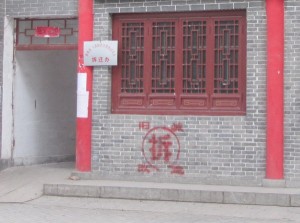You’d think that after living in China for 15 years I’d be used to certain things. For example, traffic flow. I’m not just talking about motorized transportation here; I’m especially referring to pedestrian traffic, since I don’t do a whole lot of driving in China. As in, zero.
Anyway, it appears that, judging from the level of frustration that I’ve been experiencing recently, three years of living back in the U.S. has re-programmed my expectations in this area. Here’s a graphic to illustrate the cause of my frustration:

The blue on the left represents the Western way of dealing with problems – we walk right through them. We deal with them, we “solve” them.
The red on the right represents the Chinese way of dealing with problems – they avoid them, walk around them, ignore them.
Of course, these two representations are generalizations, and as we all know it’s dangerous to make generalizations. However, based on my experience of the last couple months, I’d say it’s pretty accurate, at least in the area of pedestrian traffic.
In the U.S., we have an unspoken rule that everyone is supposed to walk on the right. We have another unspoken rule that says if you want to stop and deal with something, you do it out of the flow of traffic so you won’t hold everyone up. This probably has a lot to do with the fact that U.S. culture is so much of a car culture, and we subconsciously apply the rules of the road to the sidewalk.
In China, it wasn’t even legal to privately own a car until the mid-90’s! So don’t even think about a car culture. No, it’s a pedestrian culture with millions and millions of drivers now applying the unspoken rules of the footpath to the highways. In other words, if you’re in front, you have the right of way, even if your bumper is 3 inches further in front than my bumper. So you can crowd into my lane, and I’ll just crowd into the lane next to me to make room for you crowding into my lane. And if I need to get to a road that’s not directly accessible from the road where I’m driving, I’ll just turn into the oncoming traffic to get to the road I want to get to.
Fortunately, as I said before, I don’t drive in China, so I don’t have to deal with this type of driving. However, the most common place to observe the Chinese version of the above graphic is on the sidewalk. There’s no such thing as walking on the right, or moving slightly out of the path of traffic if you want to stop.
Now think about trying to apply the American rules to Chinese pedestrian traffic. Yeah. Instant and continuous frustration.
And the worst part is, I know it’s my problem, not theirs!


